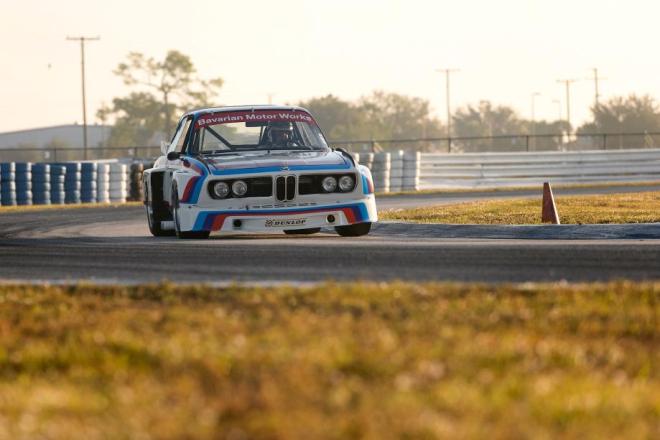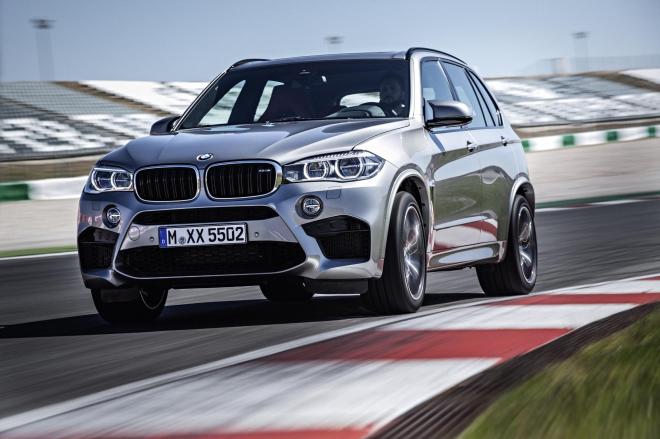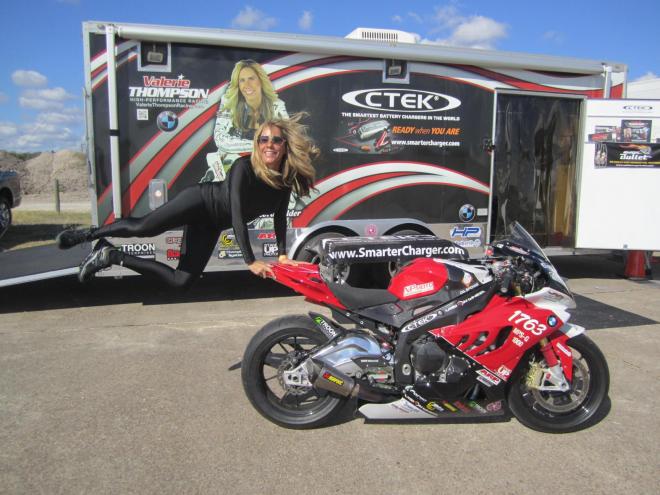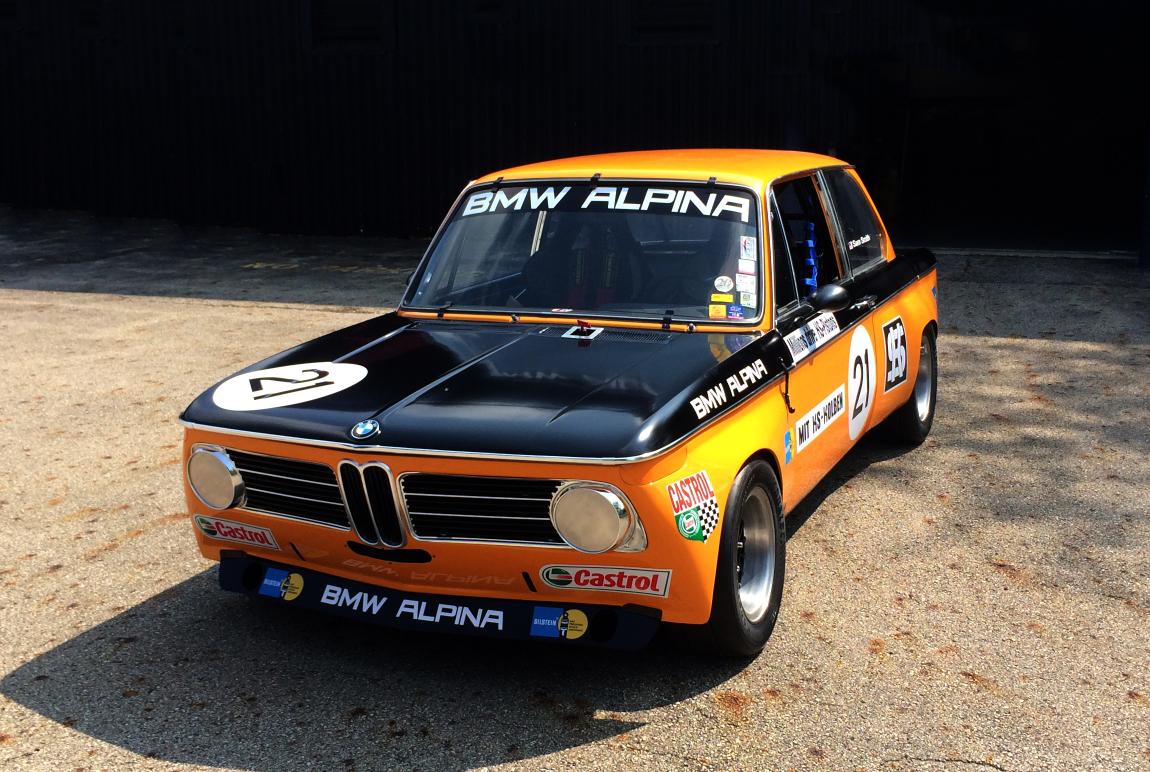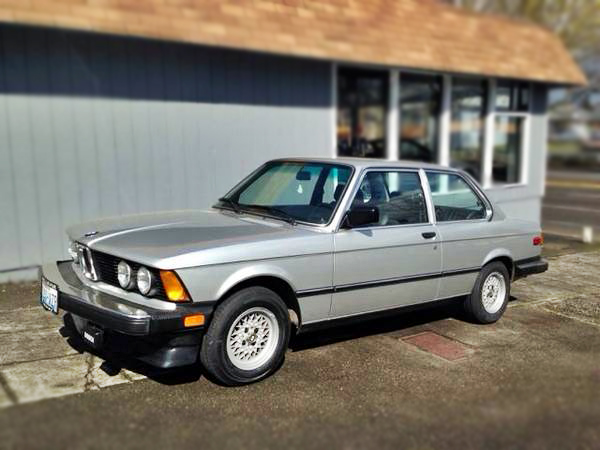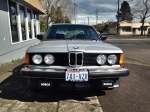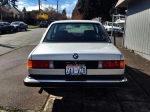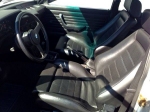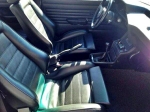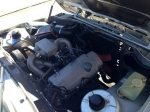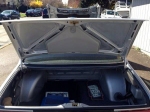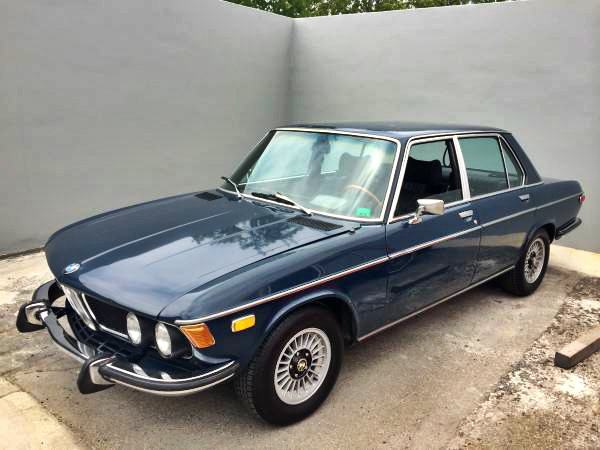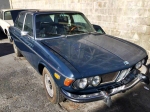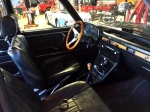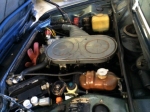
Woodcliff Lake, N.J. October 29, 2014 7:00pm EDT/4:00pm PDT…The new BMW X5 M is setting the pace once again in the high-performance Sports Activity Vehicle (SAV) segment. When the previous generation arrived in 2009, it was the first time the high-performance character distilled by BMW M GmbH had been transplanted into an all-wheel-drive BMW X model. The result was class-leading dynamics. The new BMW X5 M pulls no punches in writing the next chapter in this success story with another significant step forward in dynamic excellence, distinct M design and outstanding efficiency. The 2015 BMW X5 M will be offered at a Manufacturer’s Suggested Retail Price of $99,650, including $950 Destination and Handling, and will arrive in US showrooms in the Spring of 2015.
The new BMW X5 M combines the characteristic features of the successful BMW X family – exclusivity, robustness, agility and everyday usability – with the commitment to high performance that defines an M vehicle. The latter is resoundingly highlighted by the vehicles’ impressive performance figures. Both models complete the sprint from 0 to 60 mph in 4.0 seconds in conjunction with the new eight-speed M Steptronic transmission.
Innovative engine technology.
The new M TwinPower Turbo V8 for the BMW X5 M is the most powerful engine ever developed by BMW for an all-wheel-drive vehicle. Boasting innovative M TwinPower Turbo technology with a pair of TwinScroll turbochargers, cross-bank exhaust manifolds, VALVETRONIC and High Precision Direct Injection, the 4.4-liter V8 produces maximum output of 567 hp between 6,000 and 6,500 rpm. That represents a 3 percent increase over the predecessor models. The step up is even clearer when it comes to the power development of the new engine. Peak torque has been boosted by 53 lb-ft which equates to a rise of 10 percent. Its 553 lb-ft can be enjoyed across a broad rev range between 2,200 and 5,000 rpm.
At the same time, fuel consumption of the new BMW X5 M in the European cycle (official EPA values will be available closer to the start of sales) has been cut by 20 percent, CO2 emissions are likewise down by more than 20 percent, to 258 g/km. The two models accelerate from 0 to 60 mph in 4.0 seconds through the standard eight-speed M Steptronic transmission with Drivelogic. Top speed is limited to 250 km/h (155 mph).
Powerful looks and exclusive equipment.
With its striking use of forms, the looks of the new BMW X5 M foretell its performance potential. With its exterior painted fully in body color, it cuts a low-slung figure on the road, while mixed tires showcase its sporty track width. Additional exterior design modifications, moreover, elevate the M even further than before from the standard BMW X5. Large air intakes at the front end, side gills with a model badge and Air Breathers, signature M exterior mirrors in twin-stalk style, and a typically M four-tailpipe exhaust system gives it a standalone look M fans will immediately recognize. Setting the seal on this exclusive range of features are standard M-specific, forged 21-inch M light-alloy wheels.
The high-quality interior impresses with its well-thought-through combination of sporty features, exclusive materials and flawless workmanship. The M instrument cluster, M leather steering wheel with aluminum gearshift paddles and M gearshift lever – which works in the same way as the familiar M Double Clutch Transmission gearshift lever – are complemented by electrically operated M multi-function seats for the driver and front passenger, an M driver’s footrest and the optional Head-Up Display which, in addition to the standard information, also includes an M-specific display with gear indicator, rev band and shift lights.
New BMW X5 M customers also have the choice between various options exclusive to the M models, such as Merino full-leather trim. And there’s also a choice of two new and exclusive M paint finishes – Long Beach Blue Metallic and Donington Grey Metallic.
A finely balanced overall concept.
At BMW M GmbH, high performance is about more than engine output and top speeds alone. Here, high performance means all of a vehicle’s components working in perfect harmony and the precise interplay of various details resulting in maximum performance, agility, precision, poise and assurance out on the road. This sense of balance is a defining feature of all the vehicles produced by BMW M GmbH and is, needless to say, also present in the new BMW X5 M.
Function-led design.
The function-led design of the new BMW X5 M is immediately clear with athletic, muscular looks betraying their high-performance credentials before they so much as turn a wheel. The four large air intakes and flaps at the front end, and the diffuser at the rear, are fully functional, they are an essential part of the engineers’ drive to optimize aerodynamics and ensure efficient cooling.
Thanks to a clever aerodynamics concept, the airflow is guided so efficiently around the vehicle that drag is minimized and lift is also reduced. The engine, powertrain and brakes are all kept sufficiently cool, even when placed under extreme loads on the track. Elements which look like pure design accents when they first catch the eye, in fact, fulfill functional tasks. For example, the M-specific Air Breathers behind the front wheels reduce turbulence in the front wheel arches.
Optimum temperature management.
The high-performance engine under the hood of the new BMW X5 M requires a high-performance cooling system in order to guarantee the optimum operating temperature in all conditions – i.e. normal everyday driving, stop-start traffic and extreme action on the race track. A highly efficient, newly developed combination of low-temperature and high-temperature radiators, which also handles the cooling of the turbochargers, charge air and transmission oil, maintains an optimum temperature, even with all components working flat out.
New Eight-speed M Steptronic transmission with Drivelogic.
The new BMW X5 M sends its engine power to the wheels via the newly developed eight-speed M Steptronic transmission with Drivelogic, which closely follows the operating philosophy of the M Double Clutch Transmission used by other M models. With its instantaneous responses, rapid gear changes and direct reaction to load changes, the torque converter automatic transmission links up seamlessly with the new higher-torque turbocharged engine and showcases its talents. At the same time, its wider ratio spread allows it to offer a clear drop in fuel consumption over the six-speed transmission offered in the previous generation, as well as an increase in driving comfort and improved performance.
The new eight-speed M Steptronic transmission allows drivers to sit back and enjoy automatic shifts or change gear manually using the gearshift paddles on the M leather steering wheel. And for the perfect getaway, the driver can activate the Launch Control system adapted from use in racing vehicles. Here, the driver keeps their foot on the brakes and pushes the accelerator down almost to the floor, which prompts the system to dial in the ideal getaway rpm. Releasing the brakes prompts Launch Control to let the vehicle off the leash, and it accelerates off the line with maximum propulsion.
The driver can also use the three-stage Drivelogic function to choose whether to prioritize fuel economy, comfort or Sport performance. This functionality is available both in automatic and manual shifting modes.
Intelligent all-wheel drive.
BMW xDrive intelligent all-wheel drive and Dynamic Performance Control play a key role in the outstanding dynamics of the new BMW X5 M. The xDrive system employs an electronically controlled multi-plate clutch to allow fully variable distribution of drive between the front and rear axles – from 100 percent at the rear to up to 100 percent at the front. This ensures the best possible traction in all road conditions. In the interests of greater agility, xDrive normally operates with a rear-biased torque split-in the BMW X5 M.
Dynamic Performance Control oversees the continuous distribution of torque between the rear wheels – both under load and on the overrun – regardless of engine output. Working in combination with the xDrive all-wheel-drive system, the result is a whole new bracket of dynamic flair, agility and traction. The vehicle follows the course set by the driver far more accurately, whatever the road surface, and the system also reduces the amount of wheel work required of the driver: the steering responds more directly and far fewer corrections are necessary. Moreover, the inherent propensity of conventional all-wheel-drive vehicles to understeer is eliminated. An improvement in traction is also impressively noticeable (on road surfaces with differing friction levels, in particular), and active safety is markedly enhanced as a result. The driver can see how Dynamic Performance Control is operating on the display, with arrows at all four wheels visualizing where the engine power is currently being sent.
An open door to controlled drifts.
Among the other highlights of the overall concept behind the new BMW X5 M is Dynamic Stability Control (DSC). The control functions of DSC have been Optimized over previous versions of the system to improve driving dynamics further still. The extra functions which have become part of DSC enhance active safety (Brake Standby, Brake Drying, Fading Compensation) and comfort (Start-Off Assistant, parking brake with automatic hold function).
Dynamic Stability Control allows the driver to choose from three modes: DSC on, MDM (M Dynamic Mode), DSC off. While DSC on counteracts understeer and oversteer to great effect with selective brake activation and torque reductions, MDM allows greater wheel slip – to give keen drivers the chance to execute some mild drifts. However, the driver aids will also intervene to assist the driver in this mode if a predefined limit is exceeded. Deactivating DSC (through DSC off) gives the driver the chance to fully explore the vehicle’s limits on the track and nudge the vehicle into power oversteer (i.e. a drift) using the accelerator. In this mode, the system will only intervene in extreme situations involving significant shifts in lateral acceleration.
The new M TwinPower Turbo engine. A V8 with even more torque, backed by an emotionally rich soundtrack.
To say the newly developed engine of the new BMW X5 M has a pounding heartbeat would be something of an understatement. After all, the 4.4-liter V8 uses innovative M TwinPower Turbo technology – consisting of cross-bank exhaust manifolds, a pair of TwinScroll turbochargers, High Precision Direct Injection and VALVETRONIC – to push torque and output to higher levels still. This unrivalled combination ensures that a strong wave of torque is maintained from low revs and allows direct and rapid responses, linear power delivery and customary M soundtrack.
Maximum performance meets outstanding efficiency.
The peak output of the new M turbocharged engine powering the BMW X5 M is, at 567 hp, three percent higher than that of its predecessor and is available between 6,000 and 6,500 rpm. At the same time, the engine’s peak torque has been boosted by around 10 percent to 553 lb-ft, which can be enjoyed across an extremely broad rev band – from 2,200 to 5,000 rpm. The extraordinary power development of this M turbocharged engine allows the new M version of the BMW X5 to sprint from 0 to 60 mph in a mere 4.0 seconds. The top speed of both is electronically limited to 155 mph.
The outstanding efficiency of the new M TwinPower Turbo engine is illustrated by its 20 percent lower fuel consumption and emissions in the in the European cycle (official EPA values will be available closer to the start of sales) compared to its predecessor. All of which means that the range of the two vehicles on a single, identically sized tank of fuel has increased by 26 percent to 475 miles) in each case (European cycle).
Optimized responses.
The turbocharged V8 engine fitted in the BMW X5 M delivers impressive performance with lightning-fast responsiveness. The key factors here are the engine’s High Precision Direct Injection (2900 psi injection pressure), state-of-the-art VALVETRONIC system and cross-bank exhaust manifolds, which send two converged exhaust gas streams to drive the two TwinScroll turbochargers through four separate exhaust ducts.
The new engine features a closed-deck crankcase with an extremely rigid construction. This enables higher cylinder pressures to be achieved, paving the way for improved power output. A forged, torsionally stiff crankshaft is used to transfer the impressive torque, its low weight contributing to a significant reduction in rotating masses and thus a further sharpening of the engine’s responses.
From race track to road.
In the development of every model at BMW M GmbH, a familiar maxim applies: it must be “fit for the Nordschleife”. The aim in the development of BMW M cars is to master the world’s most challenging race track at race speed without a hitch. The extreme lateral and longitudinal acceleration generated when lapping the Ring places huge demands on the engine’s oil supply. But sophisticated oil sump and suction snorkel geometry allows the new BMW X5 M to safely operate up to 1.2 g lateral acceleration.
The cooling system for the new BMW X5 M is similarly track-ready, as highlighted the first time you set eyes on the vehicles by the large air intakes in the front end. A combination of low-temperature and high-temperature radiators ensures that the optimum temperature is maintained for engine cooling fluid, charge air, engine oil and transmission oil – even when venturing into high-performance territory.
The exhaust system has been modified to satisfy the sporting ambitions of the new M models. A distinctively familiar BMW M engine note resonates out across the whole rev range via electrically controlled flaps, which open or close according to demand, and sounds even sportier and richer than that of its predecessor. Selecting one of the preconfigured driving modes, moreover, engages a finely balanced set-up that also provides acoustic feedback on the engine load at any one time.
The chassis. Hitting the heights of agility, precision, poise and assurance.
The new BMW X5 M once again sets the pace in the high-performance Sports Activity Vehicle segment thanks to extensive chassis upgrades. These combine to provide outstanding performance together with unbeatable directional stability and excellent traction, along with the type of neutral self-steering typical of M vehicles, in particular when accelerating out of corners and approaching with the dynamic limits.
To this end, the double-wishbone front suspension features revised kinematics. A modified upper wishbone (increase in camber, optimized camber progression and steering pivot axis) allows a further increase in cornering force potential and agility. At the same time, M-specific elastokinematics with more rigid bearings improve wheel guidance and therefore directional stability – both at the front suspension as well as the Integral-IV rear suspension (an independent suspension system with anti-squat and anti-dive geometry). Firmer suspension spring tuning and a 10-milimeter drop in ride height team up with the Active Roll Stabilization to bring about an effective reduction in body roll, pitch and yaw. In addition, the BMW X5 M and BMW X6 M come standard with self levelling rear air suspension. Dynamic Damper Control with electronically adjustable dampers – the driver can select from three modes (COMFORT, SPORT and SPORT+) at the touch of a button – ensures the perfect balance between dynamic flair and ride comfort.
Mixed tires for optimized handling.
Another central element in the driving characteristics of the new BMW X5 M are the special tires, whose development closely followed that of the front and rear axle design. In the high-performance segment, tire choice for the front axle focuses – alongside lateral stability and brake forces – primarily on steering precision and feel. By contrast, the engineers’ attention in the development of the rear tires centerd on traction, lateral stability and directional stability. In order to meet these part-contradictory, part- complementary demands, the BMW M GmbH engineers have developed two sets of mixed tires for the new BMW X5 M. The interconnected development of tires, steering and axles endows the new vehicles with assured handling properties and good rolling comfort. Both models are fitted standard with low-weight non-runflat 21-inch forged wheels (front: 10 J x 21, rear: 11.5 J x 21) shod with Michelin Pilot Super Sport UHP tires (front: 285/35 R21 Y, rear: 325/30 R21 Y).
M Servotronic steering with individual adjustment.
One of the most important interfaces between driver and vehicle is the steering. Here, BMW M GmbH’s high-performance models have set the benchmark from day one when it comes to providing a direct steering feel, precise feedback on the driving conditions and a finely-tuned balance when exploring the dynamic limits. Continuing this tradition, the M Servotronic steering in the new BMW X5 M comprises M-specific gear ratios and an intelligently composed overall set-up. This rack-and-pinion system with electric power assistance uses no energy when the vehicle is travelling straight ahead. The Servotronic function familiar from hydraulic systems, which controls the degree of steering assistance according to the vehicle’s speed, is another integral element. Furthermore, drivers can choose from three steering settings (COMFORT, SPORT, SPORT+) – at the touch of a button in the center console or by storing their preferred settings in the M Drive buttons – to adjust the steering characteristics to personal tastes or the situation at hand.
High-performance brakes borrowed from motor sport.
The remarkable high performance potential of the BMW X5 M is backed up by the M compound brakes with large six-piston fixed calipers at the front and single-piston floating callipers at the rear. Excellent stopping power, precise feel, low weight and increased resistance to heat are their headline features. The brake discs in compound systems – which were originally developed for racing – use a cast iron, ventilated and cross-drilled rotor mounted to an aluminum hat. The surface of the brake pads is 50 percent larger compared with those on the predecessor models. At the same time weight is down by 1.6 kilograms, helping to reduce unsprung and rotating masses. This also contributes to the improved acceleration, responsiveness and handling of the BMW X5 M. The compound brakes signal their performance capability visually as well. All the brake discs are perforated and inner-vented, and the brake callipers are painted in Dark Blue metallic, in typical M fashion, and marked at the front wheels with the M logo.
The design. High performance, even when standing still.
The outstanding performance of the new BMW X5 M is also showcased through its M design signatures. The proportions provide an instant showcase of its muscular power and elegance, not to mention its impressive versatility.
The new BMW X5 Mhas been designed for use on the road. It combines the raised seating position of an all-wheel-drive BMW X model with the outstanding overall concept balance of a BMW M vehicle. In order to visually reinforce the further improved on-road attributes of the new M models, the whole body is painted the same color. In combination with a 10-millimeter reduction in ride height and the wider track created by the use of mixed-size tires, the vehicle has a lower, more powerful stance, cut an even sportier figure even when stationary, and as a result enjoys a very distinct personality when compared with its BMW X5 sibling.
Visually striking yet fully functional front end.
The front-end design of the BMW X5 M is likewise a clear departure from that of the respective standard model and follows the classic “form follows function” maxim. The large air intakes and voluminous “kidneys” of the radiator grille, with the now customary M double-bar look, are mandated by the high cooling air requirements of the powerful engine, transmission and high-performance front brakes. Despite the large amount of cooling and more stringent pedestrian protection requirements, the designers have managed to integrate foglamps into the front end of the vehicles. The new M model borrows its headlights from the BMW X6, complete with headlight washer system. Elsewhere, the special flaps low down in the outer air intakes –adapted from those on racing vehicles – reduce lift and emphasise the optimized aerodynamics of the two new models.
Powerful rear end with racing accents.
The rear end of the BMW X5 M also differs significantly from its standard sibling, exuding a stronger aura and majoring on bold, sporty accents. This approach is underlined in particular by the wide rear tires (which are a different size from the fronts), the distinctive M rear aprons painted in body color and the hallmark M four-tailpipe exhaust. The diffuser element (likewise in body color) adapted from racing vehicles helps to ensure aerodynamically optimized airflow at the lower edge of the rear bumper moulding, allowing the new M model to highlight once again the impressive functionality of its design features.
Sporting ambience and flawless ergonomics.
As with all vehicles from the BMW brand, the design of the interior prioritizes intuitive, quick and error-free usability. And M GmbH also makes its own distinctive mark here. For example, the BMW X5 M comes with a newly developed, ergonomically optimized M leather steering wheel with gearshift paddles, while the M gearshift lever has an equally distinctive design. The instrument cluster, M Drive menu in the information display, displays in the optional Head-Up Display and special multifunction switch with M Drive buttons on the steering wheel also fit the M template.
The sporting ambience on board the new BMW X5 M is accentuated by the exclusive, electrically operated M Multifunction seats for the driver and front passenger – in fine-grain Merino leather with contrast stitching and embossed M logo in the backrests – and by the leather-covered BMW Individual instrument panel. Door sill strips with model lettering, aluminum interior trim strips and the standard Alcantara anthracite roof liner lend the interior an additional touch of exclusivity.
High-quality standard equipment and options.
The new BMW X5 M comes with an extensive range of exclusive equipment from the factory which illustrates their character as high-performance Sport machines that can be used every day. Customers can also dip into a large selection of optional equipment with which to make their vehicle even sportier, for example, or to satisfy the most exacting requirements in terms of comfort. Standard-fitted exterior features painted in body color and fitting the classic M profile are a key factor in the striking appearance of the new BMW X5 M. These include a front apron with large air intakes, a double-bar kidney grille, familiar M twin-stalk exterior mirrors, side gills with the M logo and Air Breathers, a rear apron with integrated diffuser and a four-tailpipe exhaust system in chrome. It is fitted with standard forged 21-inch BMW M light-alloy wheels in Orbit Grey and with mixed non-runflat Michelin Pilot Super Sport tires.
High-quality interior with an exclusive allure.
Elegance and impressive functionality are also defining features of the interior of the new BMW X5 M. As well as the new M leather steering wheel with integrated aluminum gearshift paddles and M multi-function seats in Merino leather for the driver and front passenger (with electric adjustment and memory function), the M-specific standard equipment also includes a Nappa leather dashboard, an Alcantara anthracite roof liner, aluminum interior trim strips, door sill finishers with model lettering, knee pads on the center console and an M footrest for the driver.
Likewise included as standard equipment for the new BMW X5 M are an alarm system, power tailgate, automatically dimming rear-view and exterior mirrors, a headlight washer system, 4-zone automatic climate control, a Harman Kardon surround sound system, Park Distance Control rear-view camera. Xenon and adaptive headlights are also part of the standard equipment for the BMW X5 M. These items are in addition to the driver assistance systems familiar from the regular BMW X5 and the mobility services from BMW ConnectedDrive. Among the highlights here is the new-generation Navigation system Professional, which boasts even greater capability and sharper graphics and incorporates 3D elements into its map display.
In keeping with its high-performance pretensions, the new M model also comes as standard with an M-specific instrument cluster – complete with displays showing the gear selected, system status (engine dynamics, Dynamic Damper Control, M Servotronic), M Drive mode and a compass, the M Drive menu in the information display and M-specific buttons on the M leather steering wheel. Over and above the information projected by the standard system, the optional Head-Up Display for the new BMW X5 M also features a special M display including a digital speed display, gear display, rev band and Shift Lights.
Accurate analysis of driving style with the M Laptimer app.
BMW M GmbH has developed the BMW M Laptimer app for smartphones so customers can access extensive analysis of their personal driving style on the track. With the smartphone linked up to the vehicle, the BMW M Laptimer app can be operated using the iDrive Controller. The app records the vehicle’s speed, lateral and longitudinal acceleration, the gear currently engaged, steering angle and accelerator position. This data can subsequently be used to precisely analyze the driver’s actions and reactions at the various points around the track via graphic displays on the customer’s smartphone. Another feature allows two recordings on the same track to be compared corner-by-corner. The readings used here can be either the driver’s own or data shared by other drivers via email or social networks.
The all new 2015 BMW X5 M will make its World debut at the 2014 Los Angeles International Auto Show and arrive in US showrooms in early 2015.




